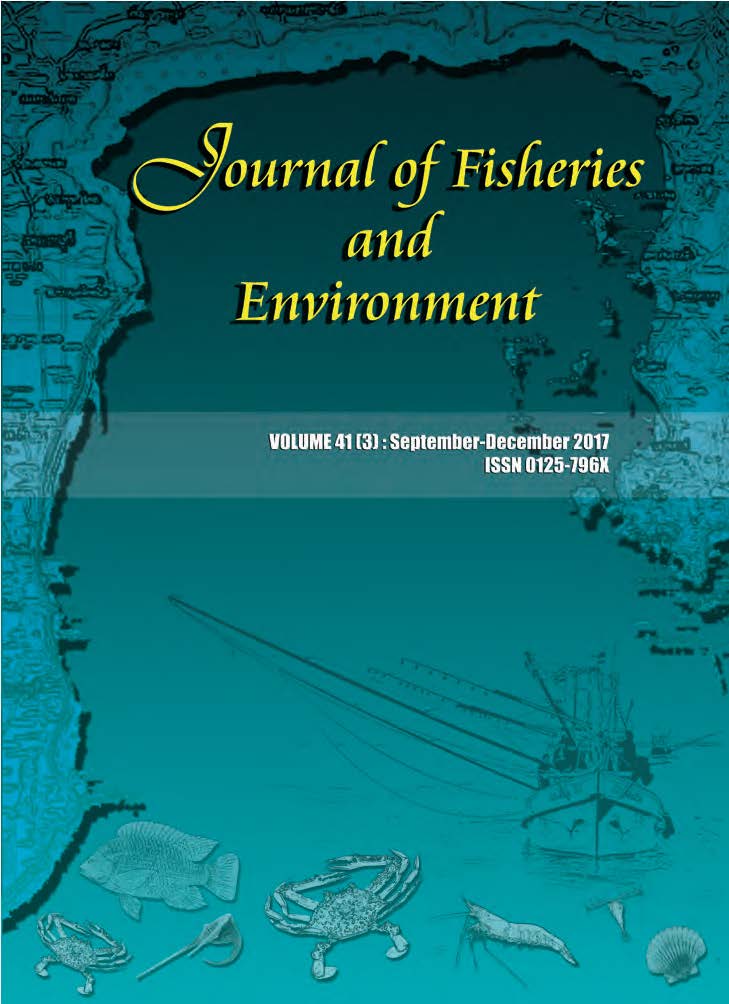Chemical and Mineral Compositions of Sargassum spp. from Bo Mao Beach, Chumphon Province, Thailand
Main Article Content
Abstract
Sargassum spp. or brown seaweeds have been used as food by the people in Pathio district, Chumphon province, south Thailand. This study is the first time that an investigation on the chemical and elemental compositions of Sargassum spp. found in the area has been conducted. Three species of Sargassum, namely Sargassum binderi, S. polycystum and S. oligocystum from Bo Mao Beach in Pathio District of Chumphon province were collected from September 2014 to February 2015. Results showed that the chemical compositions such as moisture, ash, crude protein, crude lipid and crude fiber of S. binderi were 5.61±0.00, 14.73±0.14, 5.96±0.03, 2.02±0.01 and 13.78±0.99% dry weight, respectively. Whereas, the moisture, ash, crude protein, crude lipid and crude fiber of S. polycystum were 5.34±0.01, 14.20±0.13, 6.83±0.05, 2.08±0.02 and 15.44±2.64% dry weight, respectively, and those of S. oligocystum were 4.17±0.19, 24.22±0.29, 5.47±0.41, 2.62±0.06 and 12.52±0.49% dry weight, respectively. The amount of Ca, P, K, Mg and Na of these seaweeds were significantly different (p<0.05), with S. binderi containing 3.23 ± 0.08, 0.07±0.00, 1.55±0.04, 0.99±0.01 and 0.75±0.00 % dry weight, respectively. Whereas S. polycystum contained 2.28±0.08, 0.07±0.01, 1.90±0.02, 0.90±0.01 and 1.12±0.00% dry weight, and S. oligocystum had 2.17±0.01, 0.06±0.00, 6.30±0.11, 0.85±0.01 and 0.58±0.01% dry weight, respectively. This study indicated that these brown seaweed are rich in beneficial nutrients, with potential for use as food not only for humans but also for animals.
Article Details
References
2. Dhargalkar, V.K. and P. Neelam. 2005. Seaweed: Promising plant of the millennium. Science Culture. 71: 60-66.
3. Fleurence, J. 1999. Seaweed proteins: biochemical, nutritional aspects and potential uses. Trends in food science and technology. 10: 25-28.
4. Lewmanomont, K., L. Wongrat, and C. Supanwanid. 1995. Algae in Thailand. The Report of the Office of Environmental Policy and Planning, 334 pp. Bangkok, Thailand.
5. Marín, A., M. Casas-Valdez, S. Carrillo, H. Hernández, A. Monroy, L. Sanginés, and F. Pérez-Gil. 2009. The marine algae Sargassum spp. (Sargassaceae) as feed for sheep in tropical and subtropical regions, Revista de. Biologia Tropical. 57(4): 1271-1281.
6. Marinho-Soriana, E., P.C. Fonseca, M.A.A Carneiro, and W.S.C. Moreira. 2006. Seasonal variation in the chemical composition of two tropical seaweeds. Bioresource Technology. 97: 2402-2406.
7. Murugaiyan, K and S. Narasimman. 2012. Elemental composition of Sargassum longifolium and Turbinaria conoides from Pamban Coast, Tamilnadu. International Journal of Research in Biological Sciences. 1(1): 1-3.
8. Murugaiyan, K., S. Narasimman, and P. Anatharaman. 2012. Proximate composition of marine macro algae from Seeniappa Dharka, Gulf of Mannar region, Tamil Nadu. International Journal of Research in Marine Sciences. 1(1): 1-3.
9. Narasimman, S and K. Murugaiyan. 2012. Proximate composition of certain selected marine macro-algae form Mandapam coastal region (Gulf of Mannar), southeast coast of Tamil Nadu. International Journal of Pharmaceutical and Biological Archives. 3(4): 918-921.
10. Peng, Y., E. Xie, K. Zheng, M. Fredimoses, X. Yang, X. Zhou, Y. Wang, B. Yang, X. Lin, J. Liu and Y. Liu. 2013. Nutritional and Chemical Composition and Antiviral Activity of Cultivated Seaweed Sargassum naozhouense Tseng et Lu. Marine Drugs. 11: 20-32.
11. Pérez, R.C. 1997. Composición química de Sargassum spp. colectado en la Bahía de La Paz, B.C.S., y la factibilidad de su aprovechamiento en forma directa o comofuente de alginato. Tesis de Maestría. Centro Interdisciplinario de Ciencias Marinas. I.P.N., 76 p. La Paz, Baja California Sur, México
12. Sanchez-Machado, D.I., J. Lopez-Cervantes, J. Lopez-Hernandez and P. Paseiro-Losada. 2004. Fatty acids, total lipid, protein and ash contents of processed edible seaweeds. Food Chem. 85(3): 439-444.
13. Tabarsa, M., M. Rezaei, Z. Ramezanpour and J. Robert Wayland. 2012. Chemical compositions of the marine algae Gracilaria salicornia (Rhodophyta) and Ulva lactuca (Chlorophyta) as a potential food source. Journal of the Science of Food and Agriculture. 92: 2500-2506.
14. Ruperez, P. 2002. Mineral content of edible marine seaweeds. Food Chemistry. 79: 23-26.

